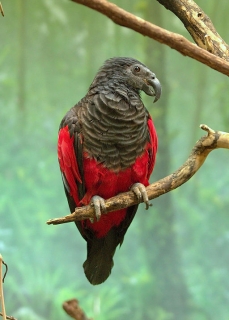Pesquet’s Parrot |
|
|
Also known as: Vulturine Parrot
Photos
View in GalleryDid You Know?
The Pesquet's Parrot is one of three parrots with bare (featherless) faces. It is thought it has evolved this way to avoid feathers becoming matted with the fruit pulp the parrot feeds on.Academic Research
Related publications: Psittrichas fulgidusSpecies Profile
Genus: Psittrichas | Species: fulgidus
Size:
46cm (18 in)
Weight:
600-800g (21-28 oz)
Subspecies including nominate:
one
Colour Adult:
Male-bare face grey/black; red mark behind eye; brown/black breast to upper abdomen; the feathers scalloped grey; red lower underparts and underwing coverts; greater and median wing coverts red. Bill black. Eye dark red/brown. Female-red mark behind eye absent.
Colour Juvenile:
As in adults but red generally duller; small red mark behind eye. Eye grey/brown.
Call:
Harsh and rasping; also described as growling. Also drawn out scream given frequently in flight.
Listen NowMore Information:
Avibase
Handbook of the Birds of the World
Content Sources:
CITES
BirdLife International
Cornell Lab of Ornithology/Birds of the World
A Guide to Parrots of the World, Juniper and Parr, 1998
ML Media Collection Catalogue 65945, Pesquet's Parrot Psittrichas fulgidus, Connop, Scott, Papua New Guinea, Oct. 11 1993, Cornell Lab of Ornithology. Site
Parrots: Status Survey and Conservation Plan 2000-2004, Snyder, McGowan, Gilardi and Grajal, 2000.
Parrots of the World, Forshaw and Cooper, 1989.
Parrots of the World, Forshaw, 2006.
Parrots in Aviculture, Low, 1992.
Parrots: Their Care and Breeding, Low, 1986.
Photos
View in GalleryDid You Know?
The Pesquet's Parrot is one of three parrots with bare (featherless) faces. It is thought it has evolved this way to avoid feathers becoming matted with the fruit pulp the parrot feeds on.Academic Research
Related publications: Psittrichas fulgidusSpecies Care
Captive Status:
Extremely rare
Longevity:
Not recorded.
Housing:
Walk in enclosure or aviary, minimum length 7m (23 ft).
Diet:
Fruits such as banana, papaya, apple, pear, cactus fruit and vegetables such as carrots, given spiked to bird-safe skewers on a perch. Fruit in nectar and rearing food made from hard-boiled egg, carrot and wholegrain bread; complete pellet.
Enrichment:
Captive birds chew on wood; provide bird-safe woods (fir, pine, willow, elder and sterilized pine cones) and vegetable-tanned leather toys.
Nest Box Size:
60cm (23 in) palm log with insides hollowed out.
Clutch Size:
2
Incubation Time:
29 days
Fledging Age:
12 weeks
Hatch Weight:
18g (0.6 oz)
Peak Weight:
Not recorded.
Weaning Weight:
Not recorded.
Photos
View in GalleryDid You Know?
The Pesquet's Parrot is one of three parrots with bare (featherless) faces. It is thought it has evolved this way to avoid feathers becoming matted with the fruit pulp the parrot feeds on.Academic Research
Related publications: Psittrichas fulgidusSpecies Wild Status
World Population:
Unknown, decreasing.
IUCN Red List Status:
Vulnerable
CITES Listing:
Appendix II
Threat Summary:
There are marked variations in local abundance with flocks from 2-6 birds up to 20 recorded. Numbers have declined drastically due to hunting, and the species has disappeared from forest near human habitation. Skins are used as bride 'price' in the highlands and are even more valuable than bird-of-paradise plumes; however, birds are also used for food. Deforestation and to some extent trapping for the bird trade are affecting the species.
Range:
Found in mountains of mainland New Guinea.
Habitat:
Found at 600-1500m (1968-4920 ft); occasionally recorded in lowlands but mainly restricted to hill and lower montane forests. Also tall secondary growth.
Wild Diet:
Feeds mainly on soft pulp of figs Ficus sterrocarpa, F. hesperidiformis and possibly F. baeuerlenii, mangoes Mangifera indica and flowers and nectar of Freycinetia mangopandans.
Ecology and Behaviour:
Large, conspicuous and encountered in pairs or in groups of up to 20 birds, perched at the top of the canopy or flying noisily through the trees. Observed roosting in one tree at dusk.
Clutch and Egg Size:
2 eggs, 44.5 x 36.5mm (1.7 x 1.4 in).
Breeding Season:
February-May. Nest is in tree cavity.
Related Links:
Wikipedia
Research: Protein requirements of a specialized frugivore, Pesquet's Parrot
Photos
View in GalleryDid You Know?
The Pesquet's Parrot is one of three parrots with bare (featherless) faces. It is thought it has evolved this way to avoid feathers becoming matted with the fruit pulp the parrot feeds on.Academic Research
Related publications: Psittrichas fulgidusMembers Only Resources
Please log-in now to find more research, resources and tools.
Not a Member?
Find more great information:
Gain exclusive access to 600+ pages of additional research, seminars and podcasts, specialists to ask your toughest questions, and dozens of other fun resources - when you become a WPT member.
Join Today >>

































